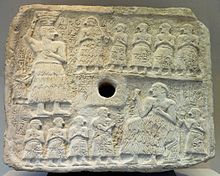Kaunakes
[6] This early type of net dress looks much more similar to standard textile than the later kaunakes , which looks more like sheepskin with ample bell-shaped volume around the waist and the legs.
In a Sumerian image dated between 2,900 and 2,600 BC, the dress was worn as a pagne, which was a simple fleece pelt used as body wrap but retaining the tail part.
[10] It was a rustic fabric made of sheepskin, camel or goat's hide fashioned in the form of a shawl or skirts called the "thick blanket" that evolved to suit the severe weather conditions of the Sumerian and Akkadian Mesopotamian region.
Coptic Egypt, not Mesopotamia, is credited with the original design of woven tapestry with projecting long locks or strands of wool.
Its manufacture evolved into kaunakes when the woven fringe design began to mirror the original fleece and fur and was shaped as a mantle.
[12] In Athens, initially the dress was thought to be of Persian origin but later it came to be identified as a Babylonian garment, as it matched with the textile practices of the northeast from Mesopotamia.



